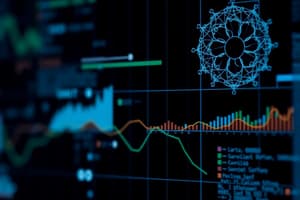Podcast
Questions and Answers
What is the measure of central tendency that represents the most frequently occurring value in a dataset?
What is the measure of central tendency that represents the most frequently occurring value in a dataset?
- Median
- Mode (correct)
- Mean
- Range
If a dataset has an even number of observations, how is the median determined?
If a dataset has an even number of observations, how is the median determined?
- The maximum value
- The mean of the two middle values (correct)
- The last middle value
- The first middle value
Which of the following is not a measure of dispersion?
Which of the following is not a measure of dispersion?
- Range
- Variance
- Mode (correct)
- Standard deviation
What is the range of a dataset?
What is the range of a dataset?
Which measure of central tendency is most sensitive to extreme values?
Which measure of central tendency is most sensitive to extreme values?
What is the formula for calculating the variance?
What is the formula for calculating the variance?
Which measure of spread is equal to the square root of the variance?
Which measure of spread is equal to the square root of the variance?
What is a significant impact of Data Science on businesses?
What is a significant impact of Data Science on businesses?
What are the three key components of Data Science?
What are the three key components of Data Science?
Which of the following is a supervised learning technique?
Which of the following is a supervised learning technique?
What is the difference between precision and recall?
What is the difference between precision and recall?
Which of the following is a data visualization technique?
Which of the following is a data visualization technique?
What is the goal of feature engineering?
What is the goal of feature engineering?
What is the purpose of cross-validation?
What is the purpose of cross-validation?
What is the purpose of hypothesis testing in data science?
What is the purpose of hypothesis testing in data science?
How can you define a function in Python that accepts an arbitrary number of positional arguments?
How can you define a function in Python that accepts an arbitrary number of positional arguments?
Which data structure is primarily used in NumPy for handling arrays?
Which data structure is primarily used in NumPy for handling arrays?
Which method is used to create a NumPy array of integers ranging from 0 to 9?
Which method is used to create a NumPy array of integers ranging from 0 to 9?
What is the default data type of elements in a NumPy array?
What is the default data type of elements in a NumPy array?
What will be the result of the operation np.array([1, 2, 3]) + np.array([4, 5, 6])?
What will be the result of the operation np.array([1, 2, 3]) + np.array([4, 5, 6])?
How can you access the element at the second row and third column of a NumPy array arr?
How can you access the element at the second row and third column of a NumPy array arr?
What followed the equation of the regression line y = 2x + 3 when x is 5?
What followed the equation of the regression line y = 2x + 3 when x is 5?
Which of the following is NOT a common assumption of linear regression?
Which of the following is NOT a common assumption of linear regression?
In logistic regression, what type of outcome does the dependent variable typically represent?
In logistic regression, what type of outcome does the dependent variable typically represent?
What is the primary purpose of conducting residual analysis in regression models?
What is the primary purpose of conducting residual analysis in regression models?
When performing polynomial regression, what effect does increasing the degree of the polynomial generally have?
When performing polynomial regression, what effect does increasing the degree of the polynomial generally have?
Which type of regression is typically preferred when dealing with multicollinearity among independent variables?
Which type of regression is typically preferred when dealing with multicollinearity among independent variables?
In the context of regression analysis, which of the following is an example of a dependent variable?
In the context of regression analysis, which of the following is an example of a dependent variable?
Given the function f(x) = x^3 + 3x^2 - 24*x + 7, what is true about x=2?
Given the function f(x) = x^3 + 3x^2 - 24*x + 7, what is true about x=2?
What distinguishes linear regression from logistic regression?
What distinguishes linear regression from logistic regression?
Which of the following accurately describes the purpose of logistic regression?
Which of the following accurately describes the purpose of logistic regression?
Which measure indicates how well the linear regression model fits the data?
Which measure indicates how well the linear regression model fits the data?
What does the correlation coefficient measure in regression analysis?
What does the correlation coefficient measure in regression analysis?
What is a primary objective of k-means clustering?
What is a primary objective of k-means clustering?
How do k-means clustering and hierarchical clustering primarily differ?
How do k-means clustering and hierarchical clustering primarily differ?
What is a limitation of using k-means clustering?
What is a limitation of using k-means clustering?
What is the function of a hyperparameter in the gradient descent algorithm?
What is the function of a hyperparameter in the gradient descent algorithm?
What is a disadvantage of using a low learning rate in gradient descent?
What is a disadvantage of using a low learning rate in gradient descent?
What is the condition on a and b for which the given system of linear equations has no solution?
What is the condition on a and b for which the given system of linear equations has no solution?
Which statement is true about the determinant of a matrix?
Which statement is true about the determinant of a matrix?
Using the provided confusion matrix for classification, how is accuracy calculated?
Using the provided confusion matrix for classification, how is accuracy calculated?
What distinguishes simple linear regression from multiple regression?
What distinguishes simple linear regression from multiple regression?
What is the goal of multivariate optimization?
What is the goal of multivariate optimization?
Which method can be used to find the minimum of a function with multiple variables without derivatives?
Which method can be used to find the minimum of a function with multiple variables without derivatives?
What does pruning in decision trees achieve?
What does pruning in decision trees achieve?
Flashcards
Key components of Data Science
Key components of Data Science
Data, statistics, and visualization are the core elements of data science.
Supervised Learning Technique
Supervised Learning Technique
A type of machine learning where the model learns from labeled data.
Unsupervised Learning Technique
Unsupervised Learning Technique
A type of machine learning where the model learns from unlabeled data.
Feature Engineering Goal
Feature Engineering Goal
Signup and view all the flashcards
Data Visualization Technique
Data Visualization Technique
Signup and view all the flashcards
Precision and Recall Difference
Precision and Recall Difference
Signup and view all the flashcards
Classification Algorithm Quality
Classification Algorithm Quality
Signup and view all the flashcards
Cross-validation Purpose
Cross-validation Purpose
Signup and view all the flashcards
Mode
Mode
Signup and view all the flashcards
Median (even dataset)
Median (even dataset)
Signup and view all the flashcards
Measure of Central Tendency
Measure of Central Tendency
Signup and view all the flashcards
Range
Range
Signup and view all the flashcards
Mean
Mean
Signup and view all the flashcards
Python random integer
Python random integer
Signup and view all the flashcards
Data Science
Data Science
Signup and view all the flashcards
Python built-in data type
Python built-in data type
Signup and view all the flashcards
Arbitrary Positional Arguments
Arbitrary Positional Arguments
Signup and view all the flashcards
NumPy's Primary Array Structure
NumPy's Primary Array Structure
Signup and view all the flashcards
Creating a NumPy Array
Creating a NumPy Array
Signup and view all the flashcards
Default Data Type in NumPy Array
Default Data Type in NumPy Array
Signup and view all the flashcards
Adding NumPy Arrays
Adding NumPy Arrays
Signup and view all the flashcards
Accessing NumPy Array Elements
Accessing NumPy Array Elements
Signup and view all the flashcards
Universal Functions (ufuncs) in NumPy
Universal Functions (ufuncs) in NumPy
Signup and view all the flashcards
Sample Variance Distribution
Sample Variance Distribution
Signup and view all the flashcards
Linear Regression
Linear Regression
Signup and view all the flashcards
Logistic Regression
Logistic Regression
Signup and view all the flashcards
R-squared
R-squared
Signup and view all the flashcards
Correlation Coefficient
Correlation Coefficient
Signup and view all the flashcards
K-Means Clustering
K-Means Clustering
Signup and view all the flashcards
Hierarchical Clustering
Hierarchical Clustering
Signup and view all the flashcards
Gradient Descent
Gradient Descent
Signup and view all the flashcards
Learning Rate
Learning Rate
Signup and view all the flashcards
Linear Regression Assumption
Linear Regression Assumption
Signup and view all the flashcards
Logistic Regression Outcome
Logistic Regression Outcome
Signup and view all the flashcards
Residual Analysis Purpose
Residual Analysis Purpose
Signup and view all the flashcards
Polynomial Regression Degree Effect
Polynomial Regression Degree Effect
Signup and view all the flashcards
Multicollinearity Solution
Multicollinearity Solution
Signup and view all the flashcards
Dependent Variable in Regression
Dependent Variable in Regression
Signup and view all the flashcards
Linear vs. Logistic Regression
Linear vs. Logistic Regression
Signup and view all the flashcards
Tuple Slicing with Indexing
Tuple Slicing with Indexing
Signup and view all the flashcards
No Solution System
No Solution System
Signup and view all the flashcards
Determinant of a Diagonal Matrix
Determinant of a Diagonal Matrix
Signup and view all the flashcards
Accuracy
Accuracy
Signup and view all the flashcards
Sensitivity
Sensitivity
Signup and view all the flashcards
Multiple Linear Regression
Multiple Linear Regression
Signup and view all the flashcards
Simple vs. Multiple Regression
Simple vs. Multiple Regression
Signup and view all the flashcards
Multivariate Optimization
Multivariate Optimization
Signup and view all the flashcards
Pruning Decision Trees
Pruning Decision Trees
Signup and view all the flashcards
Study Notes
Data Science Section A
- Data Science key components are Data, Model, and Visualization
- Supervised Learning technique is Linear Regression
- Unsupervised learning technique is K-Means Clustering
- Feature engineering goal is to transform features into a suitable representation for machine learning algorithms
- Data visualization technique is Hierarchical Clustering
- Precision measures true positives, recall measures true negatives
- Measures for classification algorithm quality include Precision, Recall, and F1 Score
- Cross-validation ensures the model doesn't overfit the data
- Linear Regression and Random Forest are classification algorithms
- Hypothesis testing purpose is to determine if a sample statistic is significantly different from a population parameter
- Null hypothesis states that there is no significant difference between a sample statistic and a population parameter
- Alternative hypothesis states there is a significant difference between a sample statistic and a population parameter
- P-value is the probability of observing a sample statistic as extreme or more extreme, assuming the null hypothesis is true
- Significance level is the probability of making a type I error
- Type II error is failing to reject a false null hypothesis
Data Science Section B
-
A data storage domain
-
Study of data to extract meaningful insights
-
Field restricted to structured data only
-
Impact of Data Science: Improved decision-making and efficiency, decreased profitability, or increased manufacturing costs
-
Built-in data types in Python include lists
-
Result of
"Hello, " + "World!"is "Hello, World!" in Python -
Pseudo-random numbers generated using the
randommodule in Python -
Primary data structure in NumPy for arrays is
ndarray -
A NumPy array containing integers from 0 to 9 can be created using
np.arange(10) -
The default data type of elements in a NumPy array is
integer -
Element access in a NumPy array is done with
arr[row, column] -
Universal functions (ufuncs) are like
sqrtin NumPy
Data Science Section C
- Gradient descent converges to local minimum (True or False)
- Covariance is not a better metric than correlation for analyzing association
- Linear regression minimizes the residual sum-of-squares (SSR)
- Cross-validation techniques include Leave-One-Out Cross-Validation (LOOCV) and k-fold cross-validation
- Classification problems include disease diagnosis and house price prediction
- Function predicting the
yvalue whenx=5in a Linear Regression equation ofy = 2x + 3is 13 - Not a common assumption in Linear Regression is linearity
Additional Topics
- The purpose of residual analysis in regression is to identify outliers and evaluate model assumptions
- A type of regression suitable for multicollinearity is Lasso Regression
Tuple Slicing
- To set
valto 20 by slicing the tupleaTuple = ("Orange", (10, 20, 30), (5, 15, 25))isval = aTuple[1][1] - Example of dependent variable is
Age - Difference between simple and multiple regression: Simple regression has one independent variable, multiple regression has more than one independent variable
- Multivariate optimization finds the minimum or maximum of a function with multiple variables
- A method for finding a minimum without derivatives in a function with multiple variables is Gradient Descent
- Pruning reduces the size of a decision tree by removing unnecessary branches
- Goal of a support vector machine (SVM) is to find the ideal decision boundary that separates the data into classes
Studying That Suits You
Use AI to generate personalized quizzes and flashcards to suit your learning preferences.



